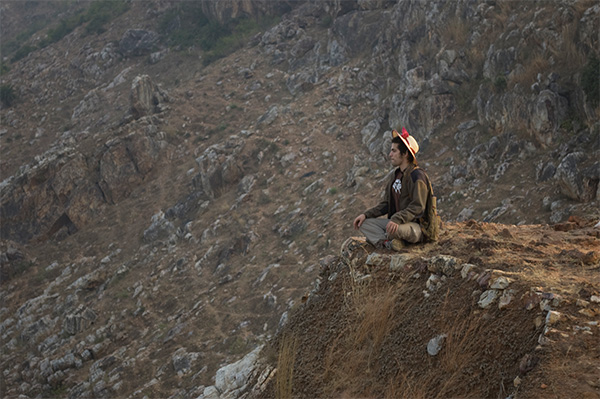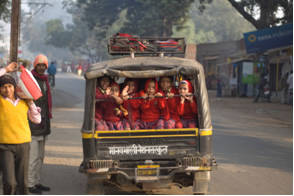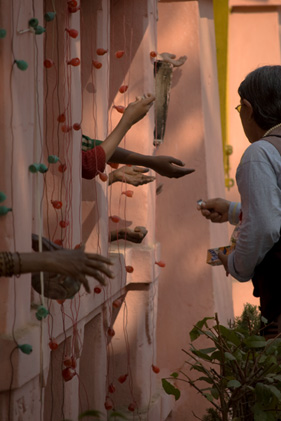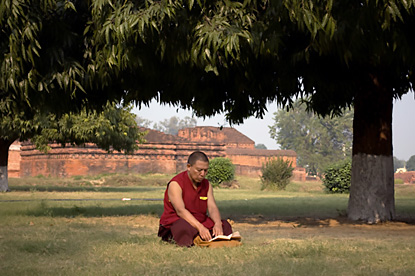|
Learning on the Throne of Enlightenment
A Semester of Buddhist Studies in India
Article and photos by Manny Fassihi

|
|
The author sitting on the ledge of a mountain contemplating during his semester of Buddhist studies in India.
|
Over the past century, Buddhism has insinuated itself into the cultural currency of America and the West. It is invoked as the guiding faith of personalities such as actor Richard Gere, former Los Angeles Lakers Coach Phil Jackson (dubbed the “Zen Master”), and, in a notorious public apology, golfer Tiger Woods. It is evoked in the glowing smile of the Dalai Lama, the images of monks protesting in Burma, and the self-help section of our bookstores. It has been described as richly philosophical, strongly ethical, and scientific in its intellectual rigor. Buddhism is both an alternative religion and an alternative to religion. But really, what is this phenomenon known as "Buddhism"?
The Buddhist Studies in India program takes the context of this question as the basis for its fall study abroad program in Bodh Gaya, India. Pioneered by Dr. Robert Pryor (who still runs the program) over thirty years ago, the program takes thirty students from various universities across America to the site of Buddha’s enlightenment for a three-and-a-half-month intensive program in Buddhist Studies, Hindi, and Tibetan language, and mediation traditions. Don’t let the “Buddhist Studies Program” title fool you — the program does not attempt to proselytize or make you a believer. At its core, the program seeks to engage the study of Buddhism through as many viewpoints as possible. Emphasis is placed on both a theoretical and practical approach so that students gain insight into what Buddhism is and how it is performed.
The program consists of four phases, all of which contribute to a supportive yet challenging introduction to Buddhism and India in general:
-
Orientation in London and New Delhi (approximately 10 days): A period when students and faculty become acquainted with one another in a more familiar environment (i.e., modernized and with fertile creature comforts such as central heating) and prepare for the culture shock of studying in an impoverished rural town in India.
-
Classes: Western Paradigms of education are used for the core courses (Buddhist Philosophy, History of South Asian Buddhism, and Anthropology of Buddhism), and Buddhist philosophies were used in the Meditation Traditions course. A regular day in Bodh Gaya looked as follows:
-
5:00 a.m. — Wakeup
-
5:30 a.m. — Meditation
-
6:30 a.m. — Breakfast
-
7:30 a.m. — Language Classes
-
8:30 a.m. — Class Period
-
10:00 a.m. — Tea
-
10:30 a.m. — Class Period
-
12:00 p.m. — Language Practice
-
1:00 p.m. — Lunch
-
4:00 p.m. — Tea
-
5:00 p.m. — Meditation
-
6:30 p.m. — Dinner
On the weekends, we continued meditation practice and occasionally traveled to other sites of interest (I went to Varanasi, the “City that was old when the Buddha was young”). Compared to the typical college schedule, the Bodh Gaya schedule is extremely taxing — students would often be in bed by 9 p.m. Regardless of the breakneck pace of the program, the intensity is counterbalanced by the boundless support available via the other students and teachers with whom you live and learn.
-
Independent Study lasts approximately one month and allows the student to conduct an ethnographic study in a Buddhist community anywhere in South or Southeast Asia (e.g., Thailand, Sri Lanka, or Laos). I went to Dharamsala, India, the de facto capital of Tibetans in exile.
-
Re-assimilation is approximately 10 days or more? Upon return to Bodh Gaya, students are furnished with tools to re-adjust to the “reverse culture-shock” of returning to the U.S. and then to apply what they have learned outside of the Indian context.
As a participant and non-Buddhist who completed the program, I gained a real sense of Buddhism's history, present vitality, and future as it manifests itself in the people and places of India. Moreover, I felt I developed the capacity to navigate the rough terrain of India by foot, rickshaw, or train, the knowledge of which I hope to impart in this essay.
Before You Get on the Plane to India
Check out Study Abroad Programs
There are many opportunities to study abroad in India, not limited to studying Buddhism alone; if meditation isn’t your interest, check out other opportunities in the many online study abroad databases. Outside scholarships like the Gilman International Scholarship can significantly help if funding is an issue.
Get a Visa!
To gain entry into India, you’ll need
a VISA from the Government of India online. The Tourist
VISA is
the cheapest and the one with the least frills, and you can choose
any period from six months to a year. Follow the instructions carefully, as any error will complicate the process.
Get your Vaccinations and Other Precautions
Because India is a tropical environment where public health standards are not well enforced, it is essential to be aware of the precautions that will keep you healthy. To prevent infection or minimize the impact that such an illness may produce, be sure to:
-
Contact your physician to work out a schedule for receiving the following
vaccinations
:
-
Tetanus/Diphtheria Immunization
-
Polio
-
Measles
-
Typhoid
-
Hepatitis A (Havrix vaccine or immune serum globulin .05 mL)
-
Optional (because the risk is low): Rabies, Hepatitis B, Japanese Encephalitis
-
Take anti-malarial medication as directed. The US Center for Disease Control (CDC) recommends Malarone (atovaquone/proguanil), Doxycycline, or Lariam (mefloquine) as malaria prevention for people traveling to India. Consult the CDC for further information.
Pack Light!
Bring one comfortable backpack or soft luggage as your checked bag and one small carry-on luggage. Take the absolute minimum — you’ll be glad when getting on and off Indian trains! Many shops throughout India carry standard toiletry items and school supplies. If possible, try to avoid bringing laptop computers, as they are very burdensome in rural India. Fear not, because the internet and computer cafés have fast broadband connections.
Use ATMs to Cash
The most reliable way to get funds to India is by using the network of ATMs. These can be cashed almost anywhere in India, including Bodh Gaya. The exchange rate between rupees and dollars generally hovers around 80Rs per US$1.
Get an International Student Identity Card
All holders of this ISIC card are automatically provided with minimal accident and sickness insurance outside the US. Details of this coverage will be sent to you with your ISIC card.
The Sacred Town of Bodh Gaya
There is no greater place to accomplish the program's goals than in the rural town of Bodh Gaya. Though primarily populated by Hindu and Muslim residents, Bodh Gaya is deeply enmeshed in the sacred geography of Buddhists worldwide as the site of Buddha's enlightenment. Over 2,500 years ago, Gautama Buddha (according to Buddhist scriptures) sat in sublime meditative repose under the canopy of a Pipala tree (known as the Bodhi tree), contemplating the nature of suffering, its root causes, and ultimate cessation for “three watchful nights.” At the end of the third night, his mind was wholly purified, and Gautama became “Buddha,” “the awakened one.”

|
|
Bus packed with children off to worship at, Bodh Gaya, India.
|
Today, droves of pilgrims from all over the world flock to Bodh Gaya to pay homage to the site of Buddha’s enlightenment, located at the Mahabodhi (“Great Awakenening”) Temple. Inside the Mahabodhi Complex is the Bodhi Tree (ficus religiosa), which is believed to be a direct descendant of the one under which the Buddha attained enlightenment. Locals joke that the biggest of these pilgrim waves comes after the arrival of the “Robert-group” i.e., the Antioch (now Carleton-Antioch) program in September. And indeed, as the local Hindu and Muslim festivals wind down by the month’s end, dozens of caravan-style tent-restaurants covered in canopies of plastic tarps, along with a Tibetan refugee market, materialize north of the main Temple. With the arrival of the winter season, hundreds of small tour and travel operators begin to spring up alongside the Himalayan merchants, and they are strewn across the public (and occasionally chaotic) space outside the Temple. On any given day during this peak season, the temple becomes a colorful site of spiritual cosmopolitanism, where monks, lay people (practicing, non-monastic Buddhists). Tourists from Japan, Burma, Thailand, Laos, Bhutan, Sri Lanka, China, England, America, Norway, and countless other countries gather.
Coping With Local Poverty

|
|
Hands of people begging for alms in Bodh Gaya, India.
|
Nevertheless, it cannot be emphasized how challenging Bodh Gaya's environment can potentially be. Though it is the nucleus of the Buddhist world, Bodh Gaya claims its home in the poorest state of India — Bihar — and has become a microcosm of the problems that beset it.
Environmental degradation, urban congestion, and
the growing creation of social ills (e.g., begging, drugs and alcohol, harassment of visitors)… were all visible to the students. A sense of injustice is palpable all around Bodh Gaya. Nowhere is this more poignantly evoked than its deplorable state of poverty. Older women, children, and beggars inflicted by polio and leprosy descend from the outer villages into the cracks, corners, and shadows of the exterior temple grounds. On the west side lane of the Mahabodhi complex, there is a prominent stronghold for the oppressed. They utilize this space to squeeze tin cups and bowls through the walled enclosure in anticipation of some donations.
Indeed, there is no way to prepare for the experience. There is no way to prepare to look at a paraplegic child in the eyes, who most likely has no parents or home to return to other than the dusty and unkempt sidewalks of the many Buddhist temples around the perimeter of Bodh Gaya. We were encouraged not to give because the money given directly is less likely to improve the lives of these children than enrich the people exploiting them. The only response that can effectuate real change is through broader institutional changes. This may be true. But it was far from an easy dilemma to grapple with on a day-to-day basis, and I would often lament being unable to do more. I advise spending some time in a given community before you start handing out money. Not only will a few days of immersion in the local culture give you a better sense of the beggars who are or may not be genuinely needy, but it will also give you a sense of how locals react. Don’t be afraid to say no. Supporting the number of philanthropic organizations growing in Bodh Gaya will go much farther than any money you give to beggars. If you would like to volunteer to help beggars in Bodh Gaya, the most credible organization is the Vajra Bodhi Society.
Engaging with the Local Community
Equally challenging for the Western student is dealing with being a walking spectacle. Strangers will regularly greet you with a heavily accented “Hello Friend!” followed by the basically friendly but ultimately annoying query that all foreigners must endure, “You are from which country?” They will follow you, consistently offering to act as your de facto guide or requesting a soft drink at the local eatery. You are already a celebrity everywhere you go based on your skin color, Western origins, and age, which can often attract unwanted attention from locals. This is especially true for Western girls, as hormonal boys have been known to shamelessly creep up on them. Generally speaking, there is little violent intent behind this rather than the Bollywood-ish fantasy of romantically pursuing love with non-natives. But that hardly removes the general unease of having a stranger perpetually breathing down your neck.
Instead of responding with barks of disapproval and exasperation, one should never take anything too seriously and learn to laugh. Anger will only amplify the unease and offer no deterrence to the people bothering you, who relish seeing “silly” Westerners overreacting. Alternatively, you can shame them; when they fail to respond to personal attacks, they react to being made a spectacle of their questionable behavior. But really, learning to respond with delightful buoyancy despite feeling personally violated is almost like completing a rite of passage. Once you open yourself up, people will begin to respect you, bother you less, and teach you much about India and what it offers. Adapting to the less private and more public space of Bodh Gaya is key to your survival, and it will help you become a more patient traveler and earn the invaluable friendship of locals.
Adapting to the Food and Drink Options
Be careful to use only the cleanest food and drinking water that conditions permit. Get plenty of rest while traveling, drink two or three liters of clean water daily, and take extra vitamins or dietary supplements to strengthen the body’s natural resistance to illness. Previous travelers have found that eating meat in India is generally unwise. Although plenty of protein supplements are available in meals (i.e., nuts, eggs, beans, grains, and milk products), some people struggle with the diet. Cut back on meat options before your trip to prepare you for this transition.
There are an abundance of great, extremely affordable readily accessible meals (approximately US$2-$3). The Bihari cuisine is well-known for its bland cuisine; Rice, lentils, roti, thick curds, ghee, papads, and pickles are what a daily meal consists of (and you can get this anywhere for around US$1-2). If this gets cloying, Mohammad’s and Om Café (not Om Restaurant) are popular meeting spots for predominantly Western and repeated visitors who take full advantage of the rich dessert menus. In these two spots is where “everybody meets everybody.” Any night, you can discuss alternate states of consciousness, overhear gossip about reincarnated lamas, or listen in on off-the-wall stories about travels in India.
Traveling India via Train
The best way to see India is not at 30,000 feet but at the ground level on the railway system. No visit to India would be complete without the experience of traveling on Indian trains, negotiating busy Indian railway stations, and listening to the hilarious croons for “Chaiii” from the chai-wallahs. Train travel is safe, cheap, and, in AC Classes, relatively comfortable. Try to go with a friend as it will make the long confinement (the train from Gaya to Dharamsala was a whopping 36 hours) more tolerable. A train station is about 40 minutes away (by car) from Bodh Gaya in Gaya. See Indian Railways for train times and fares.
Where to Stay
Monastery guest houses offer a cheap alternative to hotels, though guests are expected to adhere to their house rules. Students in the program stayed at the Burmese Vihar, a Monastery and a Pilgrims Guest House. The Vihar exists mainly to cater to groups of Burmese pilgrims. Still, there are often double-sized rooms available for others.
Nearby Places of Interest
Rajgir: The site of Vulture’s Peak, where the Buddha stayed and gave teachings on the famous Heart Sutra, one of the most important texts in the Mahayana tradition of Buddhism. Rajgir is also known for its hot springs, which are open to the public. You can commute here by commissioning a cab driver.
Nalanda: In its heyday, the ancient university of Nalanda (located near Rajgir) attracted a galaxy of luminaries, sacred and secular, from many parts of the world, e.g., China, Greece, Persia, etc. Sacked by Turks in the 12th century, Nalanda is all but a theater of dusty ruins today. Monks can still be spotted studying scripture throughout the campus, creating an interesting juxtaposition of the ancient and modern.

|
|
Monk reading from a sacred text in Nalanda, India.
|
Culture Shock When Returning Home
Returning to the States after living in what many Americans (including my parents) consider austerity seems more than bizarre. I felt estranged, out of sync, and even a bit infantile. Traffic is regulated. The refrigerator is full. Watching the news, the only stories emphasized are murders and acts of war. Indeed, this is when the trip comes full circle. Having assimilated the perspective of another tradition into my worldview, I began to realize that a geographical pilgrimage is the symbolic acting out of an inner journey. Pilgrimage is not globe-trotting, tourism, or the systematic happy-making of a vacation cruise. It involves a genuine encounter with another way of life and people. Meditating on this helps stitch together the fragmenting effect of re-assimilation into the West.
|
